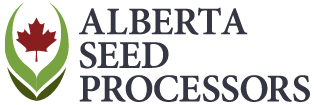July 2021 – Lacombe AB
Alberta Seed Processors (ASP) is releasing the final report on Fusarium graminearum (Fg) seed infection survey results. These results are part of a new phase of Fusarium head blight (FHB) management in Alberta.
As part of the federal government’s Canadian Agricultural Partnership (CAP), ASP launched a 3-year project in the fall of 2020 to survey Alberta Fg seed infection. The main goal of this project is to better understand how farmers can manage, control and prevent the devastating disease.
The project’s success results from the collaboration between value chain partners. ASP is collaborating with three Alberta seed labs, including SGS Canada, Seed Check Technologies and 20/20 Seed Labs, to gather data. Dr. Michael Harding, Research Scientist – Plant and Bee Health Surveillance Section of Alberta Agriculture and Forestry reviewed the data and developed the maps. Alberta Wheat & Barley Commissions supplied further agronomic and management input.
“This project directly aligns with ASP’s goals of supporting agriculture in Alberta by constantly improving the services and capacity of our seed and grain processors so we can ensure the agricultural value chain has opportunity for the best possible outcomes by identifying possible limiting factors,” says Monica Klaas, ASP’s General Manager.
The project is made possible with funding through the CAP program. CAP funding consists of a five-year, $3 billion investment by federal, provincial and territorial governments. CAP looks to provide funding to strengthen the agriculture and agri-food sector and ensure continued innovation, growth and prosperity.
Situation Summary:
Results from over 8,600 cereal grain seed samples from 60 rural and 2 urban municipalities were utilized for this final report on Fg seed infection in Alberta. Of the sample results submitted, the highest infection rate recorded was 91%. However, the majority of samples tested negative and the average infection rate was 0.346%. Ancillary data on germination and vigor levels were also collected: Germination values of 5,970 samples tested ranged from 0% to 100%, with the mean germination value being 93.21%. Vigor* values of 3,644 samples ranged from 0 to 100%, with the mean vigor value being 88.45%.
*note germination testing protocol is a standardized test, vigor testing protocol is not standardized.
FINAL REPORT TO AGRICULTURE VALUE CHAIN
DATE:
This report covers seed tested between September 1, 2020 and April 30, 2021. It is assumed the seed is from production in the 2020 crop year and is destined for seed purposes in 2021.
METHODOLOGY:
Data was collected from three Alberta-based seed testing labs and then amalgamated into one database. The database includes seed testing results for both farm-saved seed and pedigreed seed. The data is catalogued by postal code; and grouped according to a municipality.
HOW TO UTILIZE THE DATA:
Understanding pathogen sources is foundational in integrated pest management (IPM). Fusarium head blight (FHB) infection, caused by Fusarium graminearum (Fg), comes from two basic sources: wind-blown spores from crop residues such as stubble and stover/stalks, and infected seed. This project only documents detections of Fg seed infection and does not attempt to measure or quantify the risk of FHB from Fg infected crop residues. It can be assumed that when there was seed infection, it was likely caused by wind-blown Fg spores originating from Fg infected residue. Therefore, it is assumed that areas with significant levels of Fg (> 2%) grain infection have the pathogen established in crop residues and have elevated requirements for FHB management.
Sample location is reported based on the postal code to which the sample results were sent.
As a result, the second assumption is that the samples tested were produced in the municipalities where the results were sent. However, this may not be the case and therefore some sample results may be sourced from a different municipality depending on field location. For example, the map shows samples within urban municipalities- i.e.: samples tagged to Calgary or Edmonton. This means the seed sample results were sent to a postal code within those city limits but does not necessarily mean the seed was produced within city limits. Additionally, it is unknown if the grain tested will be used for seed in the future.
Despite these assumptions and limitations, the map is a helpful guide. Used in conjunction with other FHB management tools such as the Fusarium Head Blight Environmental Risk Map, the information can help evaluate risk and plan management responses. For example, in or near regions of higher disease incidence, growers are advised to participate in as many preventative FHB management activities as possible or warranted based on the risk of infection. Management activities could include using long, diverse crop rotations (2–3-year break from host crops such as wheat and corn), planting seed with the best varietal resistance to FHB, using seed with low or no Fg infection, using seed treatment with Fusarium species on the label, regular field scouting, and foliar spray protection when within IPM guidelines. Further recommendations for FHB management can be found here.
SEED TESTING DATA SEPTEMBER 2020 – May 2021


